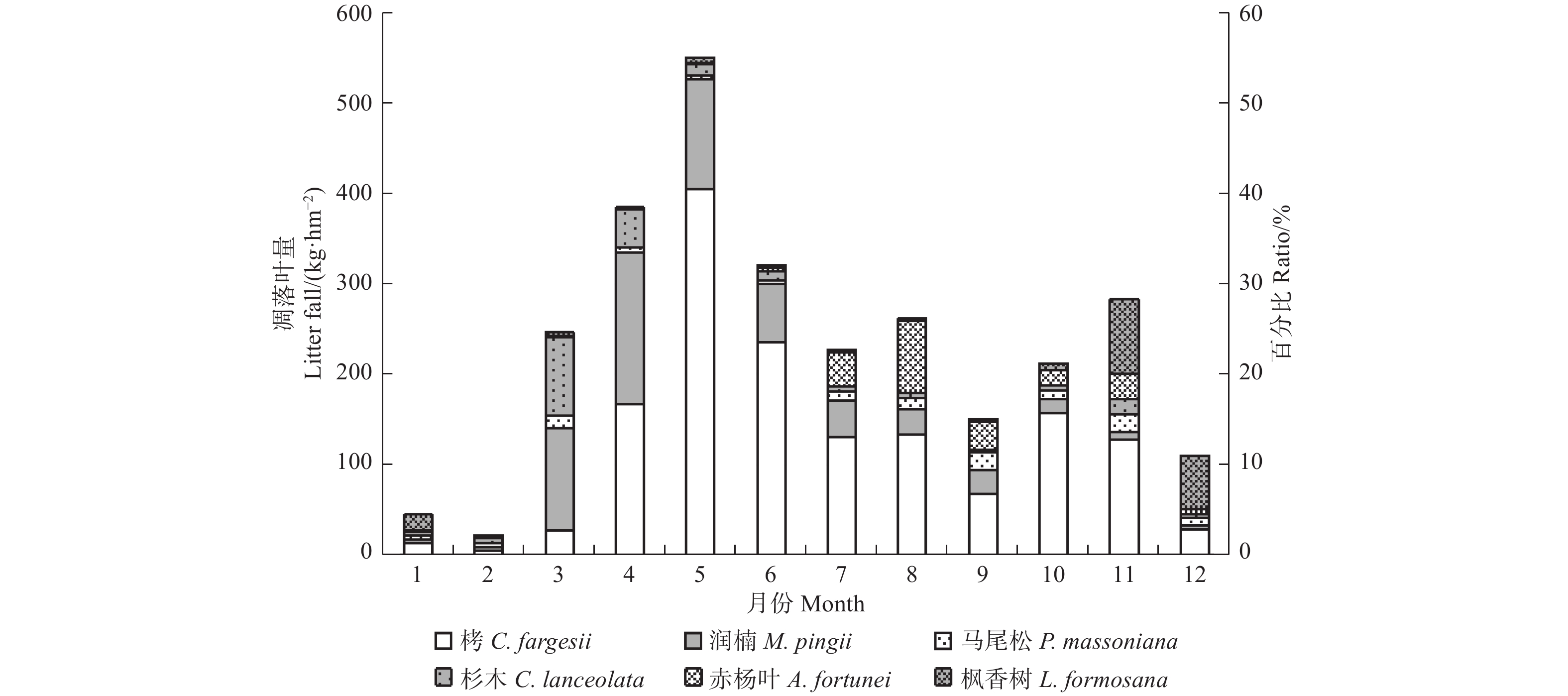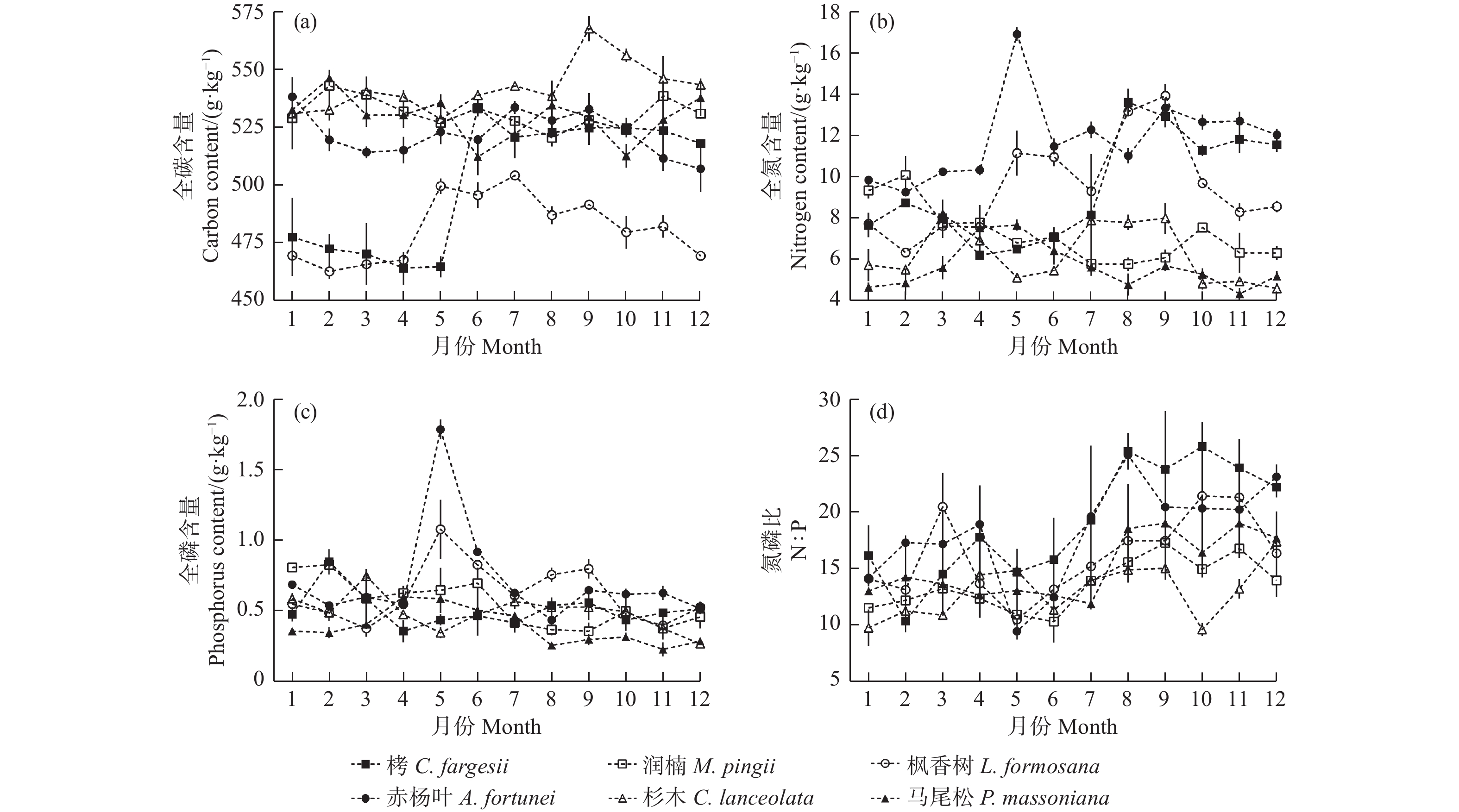-
凋落物是森林生态系统中连接植物和土壤养分的“纽带”,凋落物的凋落和分解是森林生态系统物质循环的基本过程之一[1]。凋落叶是凋落物的主要组成部分,其C、N、P含量及其比值在很大程度上反映了凋落物的分解速率、养分回归效率以及植物对土壤养分的利用策略[2-3],从而间接对一系列生态系统过程产生影响。凋落叶的C、N、P化学计量特征是目前研究森林生态系统物质循环的热点领域之一[4]。
森林生态系统的物种组成具有明显的区域特征,其凋落物的量、组成和凋落特征各不相同,从而影响生态系统过程和速率[5]。基于同一地区不同封育年限的研究表明,次生常绿阔叶林的物种组成变迁导致凋落物量和凋落节律有所差异,常绿阔叶树种在生长初期的集中落叶产生了第一个凋落物高峰,而针叶树种在生长季末的大量落叶对第二个凋落高峰的贡献更大[6]。基于鼎湖山的长期监测表明,常绿阔叶林凋落物量年际之间差异显著,且与群落的组成变化有关[7]。之前大量关于常绿阔叶林凋落物的研究主要集中于常绿阔叶树种的凋落节律,对于群落中其他生活型树种的凋落动态关注较少[8]。对同一群落中不同生活型树种凋落量及凋落节律进行研究有助于加深对常绿阔叶林物质循环过程的理解。
植物叶片C、N、P化学计量特征既反映了不同物种对土壤养分元素的利用能力及其差异化的生长适应对策,又是森林凋落物的主要组成部分,影响分解过程和元素周转效率[9]。
大量的研究表明,物候节律影响植物养分吸收策略,从而改变叶片及凋落叶中的C、N、P等元素的含量[10-12]。对北亚热带常绿阔叶林的研究表明,3个优势常绿阔叶树种叶片N、P含量在一个生长季内的模式各不相同[13]。在同样的气候条件下,人工林中常绿阔叶树种格氏栲(Castanopsis kawakamii Hayata)和常绿针叶树种杉木(Cunninghamia lanceolata (Lamb.) Hook.)叶片C、N、P含量及化学计量特征表现出明显的差异[14]。目前针对常绿阔叶林优势种(常绿阔叶树种)凋落物化学计量特征研究较多,而对同一群落中的不同生活型树种凋落叶的C、N、P化学计量特征的研究较少。
本研究在重庆市缙云山国家级自然保护区常绿阔叶林永久监测样地内对6个不同生活型树种的凋落叶进行了监测,分析不同物种叶凋落量及其凋落模式;探究凋落叶的C、N、P化学计量特征及其季节变化规律;探讨不同物种化学计量特征与其年均凋落叶产量的关系。
HTML
-
缙云山国家级自然保护区位于重庆市北碚区境内,属于亚热带季风湿润性气候。年均气温14.8 ℃,年均降水量约1 610 mm。缙云山国家级自然保护区主要以保护中亚热带湿润常绿阔叶林地带性植被为主,栲(Castanopsis fargesii Franch.)、润楠(Machilus nanmu (Oliver) Hemsley)、四川大头茶(Polyspora speciosa (Kochs) B. M. Bartholomew & T. L. Ming)和光亮山矾(Symplocos lucida (Thunberg) Siebold & Zuccarini)为该区主要优势种[5]。保护区内植物种类丰富,有维管植物约1700种,是典型的亚热带常绿阔叶林物种基因库。
-
采用典型的网格分布法将缙云山面积为1 hm2的常绿阔叶林永久监测样地均匀划分为100个10 m × 10 m的样方,在每个样方的中心点及4个顶点分别布设收集框,其有效收集面积为0.5 m2,共172个。每月末将收集框内的凋落物带回实验室,将凋落叶分离后鉴定至种后分别装入信封,于80 ℃的电热恒温鼓风干燥箱中烘干至恒质量,使用电子天平(分辨率0.0001 g)称量并记录数据。
研究对象包括栲和润楠2个常绿阔叶树种,马尾松(Pinus massoniana Lamb.)和杉木(Cunninghamia lanceolata(Lamb.)Hook.)2个常绿针叶树种以及赤杨叶(Alniphyllum fortunei (Hemsl.) Makino)和枫香树(Liquidambar formosana Hance)2个落叶阔叶树种,这6个树种相对胸高断面积之和达到68.14%,其2018年叶凋落量之和占样地凋落叶总量的63.3%(表1)。
树种 Species 生活型 Life form 叶年凋落量 Litter fall/(kg·hm−2) 相对胸高断面积 RBA/% 百分比 Ratio/% 栲 Castanopsis fargesii 常绿阔叶 1473.54 40.61 33.74 润楠 Machilus nanmu 常绿阔叶 584.30 12.09 13.51 马尾松 Pinus massoniana 常绿针叶 119.04 2.31 2.70 杉木 Cunninghamia lanceolata 常绿针叶 198.36 7.12 4.54 赤杨叶 Alniphyllum fortune 落叶阔叶 203.06 2.47 4.60 枫香树 Liquidambar formosana 落叶阔叶 186.59 3.54 4.22 Table 1. Litter fall and relative basal area of six tree species in Jinyun Mountain
-
对于同一物种,将烘干后的叶片混匀,从中随机挑选3份作为重复,共216个样本,进行元素测定。首先将叶片用球磨机粉碎成粉末,取出0.02~0.03 g放入岛津TOC-TN分析仪的固体进样舟对总碳含量进行直接测定(LY/T 1237—1999);总氮和总磷含量测定前,称取0.1 g左右粉末用98%的H2SO4和30%的H2O2在石墨炉中充分消解,然后用岛津TOC-TN分析仪测定总氮含量(LY/T 1269—1999),用钼锑钪分光光度法测定总磷含量(LY/T 1270—1999)。
-
采用多重比较对不同物种、不同生活型和不同季节的凋落叶的C、N、P含量及相应N∶P化学计量比进行差异显著性检验(P = 0.05)。所有的分析和作图在R软件中进行(R Core Team, 2015)。
1.1. 研究区概况
1.2. 研究方法
1.2.1. 凋落叶收集与研究对象选择
1.2.2. 凋落叶元素测定
1.3. 数据分析
-
缙云山常绿阔叶林凋落叶整体呈现双峰型模式。栲凋落叶月动态为双峰型,在5月达到峰值,并且在10月有一个小高峰;润楠凋落叶表现为单峰型,峰值出现在4月;赤杨叶凋落叶为双峰型,峰值出现在8月;枫香树凋落叶为单峰型,峰值出现在11月。马尾松凋落叶表现为不规则型;杉木凋落叶表现为双峰型,峰值出现在3月(图1、图2)。
-
缙云山6个树种凋落叶的C含量在481.35~542.23 g·kg−1之间,不同物种之间差异显著。N含量在5.64~11.85 g·kg−1之间,赤杨叶最高,马尾松最低。P含量在0.39~0.72 g·kg−1之间,马尾松最低,赤杨叶最高;C∶N、C∶P范围分别为45.18~97.12、825.74~1 488.15,均为赤杨叶最低,马尾松最高,N∶P范围为13.05~19.15,杉木最低,栲最高(表2)。
物种 Species C/(g·kg−1) N/(g·kg−1) P/(g·kg−1) C∶N C∶P N∶P 栲 Castanopsis fargesii 501.58 ± 28.40 b 9.47 ± 2.66 c 0.51 ± 0.14 ab 56.79 ± 14.54 b 1036.86 ± 242.31 ab 19.15 ± 5.65 d 润楠 Machilus nanmu 531.27 ± 7.50 c 7.23 ± 1.41 b 0.56 ± 0.17 b 75.92 ± 13.17 c 1045.94 ± 326.30 ab 13.58 ± 2.54 ab 马尾松 Pinus massoniana 529.56 ± 10.94 c 5.64 ± 1.11 a 0.39 ± 0.12 a 97.12 ± 17.91 d 1488.15 ± 474.18 c 15.15 ± 3.20 ab 杉木 Cunninghamia lanceolata 542.23 ± 12.21 d 6.25 ± 1.41 ab 0.49 ± 0.12 ab 90.84 ± 19.32 d 1180.07 ± 353.91 b 13.05 ± 2.62 a 赤杨叶 Alniphyllum fortunei 522.38 ± 10.13 c 11.85 ± 2.00 d 0.72 ± 0.35 c 45.18 ± 6.90 a 825.74 ± 221.93 a 18.20 ± 4.38 cd 枫香树 Liquidambar formosana 481.35 ± 14.32 a 9.53 ± 2.32 c 0.62 ± 0.21 bc 53.02 ± 10.94 ab 856.63 ± 272.19 a 16.19 ± 3.99 bc 注:同列不同字母表示差异极显著(P < 0.05)
Note: Different lowercase letters within the same column indicate significant differences (P < 0.05)Table 2. Litter fall C, N, P contents and stoichiometry of the six common tree species(mean ± SD)
-
栲、枫香树和杉木凋落叶C含量月份间波动较大,润楠、赤杨叶和马尾松凋落叶C含量月份间比较稳定(图3a);6个树种凋落叶N含量月份间的波动都较大(图3b);6个树种凋落叶P含量月份间相对比较稳定,但赤杨叶和枫香树在5月份出现一个较高的峰值(图3c);6个树种N∶P值在8—11月份明显高于其他月份(图3d)。
-
马尾松凋落叶C含量与凋落叶产量呈显著正相关关系,其他5个物种凋落叶C含量与凋落叶产量无显著相关关系(图4a);赤杨叶凋落叶N含量与凋落叶产量呈显著正相关关系(图4b);栲、马尾松凋落叶P含量与凋落叶产量呈显著负相关关系(图4c);马尾松凋落叶N∶P与凋落叶产量呈显著正相关关系(图4d)。
2.1. 凋落叶产量的季节动态
2.2. 凋落叶的C、N、P化学计量学特征
2.3. 凋落叶的C、N、P化学计量学特征时间动态
2.4. 凋落叶的C、N、P化学计量学与凋落叶产量的关系
-
凋落叶是森林生态系统凋落物的主要组成部分,其凋落节律主导着凋落物的动态[15]。在气候条件较为一致的较小的局域尺度,常绿阔叶林凋落叶季节动态以一个大峰一个小峰的双峰型最为常见[7]。尽管研究者们普遍意识到了物种组成是凋落叶量和季节动态的重要因素,然而对组成部分相对贡献的定量化研究较少[16]。缙云山常绿阔叶林凋落叶量节律呈现一大一小的双峰型分布,第一个高峰出现在5月,组成以栲和润楠为主,两者的凋落叶量占当月的61%;第二个高峰出现在11月,其中落叶阔叶树种枫香树和赤杨叶占当月叶凋落量的29%,优势栲的凋落叶在本月也占较大比例(图2)。江西官山森林样地中尽管也呈现双峰型,但由于群落中落叶树种个体数占总数的35.76%,其凋落叶高峰由落叶阔叶树种主导,表现为冬季11—12月出现一个大的凋落高峰,3—4月凋落叶高峰则较小[17]。
植物的落叶节律是适应环境形成的周期性模式,反映了物种对生态因子的响应及其在群落中的生态功能[18]。常绿阔叶树种在春夏之交出现集中的换叶过程,这种爆发式的落叶(出叶)模式有利于物种在资源竞争中获得优势[19]。本研究中,优势物种栲和润楠表现出较为相近的凋落模式,都在生长季之初产生了大量落叶,而两个物种凋落高峰时间不同步(图1)。从群落水平而言,爆发式的凋落(出叶)在时间上的分化有利于降低物种之间的竞争,促进物种的共存[20]。值得注意的是,栲在10月份出现一个叶凋落的小高峰,这可能是由于其在秋季出现第二次出叶的现象,可能是由其物种特性或对昆虫取食的适应性特征[20]。关于润楠的落叶节律研究极少,基于缙云山的研究表明凋落高峰在年际之间基本保持一致,是否存在第二个凋落高峰有待进一步研究[5, 15]。
杉木和马尾松作为广泛采用的用材树种,在我国亚热带地区分布广泛,表现出多样化的凋落节律[21-22]。缙云山杉木的凋落节律近似于双峰型,在不同年份表现出类似的模式[15]。位于北亚热带的官山大样地中,杉木凋落节律表现为单峰型[17]。缙云山马尾松的叶凋落量较少,且不同年份之间变异较大,呈不规则型[15]。同属中亚热带的湖南人工马尾松纯林凋落叶量整体呈双峰型[23]。整体而言,在亚热带地区,杉木和马尾松大多是以人工林或次生演替林的形式存在,其凋落叶表现出多样化的凋落节律[24-25]。
落叶阔叶树种赤杨叶和枫香树叶凋落动态均为单峰型,但凋落高峰时间存在差别。赤杨叶在夏季出现凋落高峰;枫香树在秋冬季出现凋落高峰(图2)。缙云山赤杨叶凋落高峰存在较大的年际变化,可能出现在8月和10月[15]。官山大样地中,赤杨叶的凋落高峰出现在10月份,其凋落高峰出现时间可能会受到物种自身节律和环境因子的综合影响[17]。缙云山枫香树凋落模式年际之间较为相似,表明其凋落节律可能相对稳定[15, 23]。
-
C、N、P是植物组织和器官的基本元素,其含量以及相对比例对植物功能具有重要的影响,也是生态系统功能的重要基础[26]。关于凋落叶化学计量学研究很多,而涉及季节动态的相对较少[24, 27-28]。本研究表明,缙云山常绿阔叶林凋落叶C、N、P化学计量特征与物种和凋落月份具有显著的相关性(表2)。6个树种凋落叶C含量接近于或显著高于全球平均水平(463.2 g·kg−1),表明缙云山常绿阔叶林生产力较高,是C储存能力较强的库[29]。本研究的4个阔叶树种凋落叶中N、P均小于全球平均水平(N: 12.12~12.30 g·kg−1、P:0.84~0.94 g·kg−1);针叶树种的N含量与全球水平(6.69 g·kg−1)相差不大,而P含量显著低于全球平均水平(0.62 g·kg−1),其原因可能是我国东部降水量较高导致的N流失和土壤中P含量较低共同决定的[30-31]。在缙云山常绿阔叶林中,杉木和马尾松大多是人为栽植的,较弱的竞争能力导致针叶树种在群落中逐渐被竞争排除,这可能也是其凋落叶中P元素含量显著低于全球水平的原因之一。凋落叶N、P含量具有一定的同步性,反映了不同生活型物种在获取资源速率和竞争能力上存在差异[32-33]。
植物生长具有明显的物候节律,不同树种、不同生长阶段的叶片元素含量具有较大的差异[12]。本研究中,栲和枫香树凋落叶中的C、N含量在生长季显著高于非生长季,可能是因为节律性的叶片凋落前,普遍会发生营养重吸收的现象,因此表现为生长季C、N含量显著高于由于集中换叶期的凋落叶(图3a,3b)。栲作为优势物种,凋落叶中的P元素含量与凋落叶量负相关,表明栲在叶片凋落前转移的P元素较多,提高了养分利用效率,减少了对环境养分的依赖,从而在该地区具有竞争优势,可能是其成为P元素较为贫乏的缙云山常绿阔叶林优势物种的重要原因之一[34]。马尾松凋落叶中P元素含量与凋落叶量负相关,且N∶P值与凋落叶量正相关,表明其对P元素较为敏感(图3c,3d)。其他研究表明,亚热带地区马尾松凋落叶N、P含量在生长季高,而在非生长季较低。这可能表明P元素的限制可能是马尾松出现不规则落叶的原因之一[24, 27]。
凋落叶中的C∶N和C∶P可以作为植物生长和凋落物分解速度的指示指标,而N∶P可以反映生物生长发育的限制因子[2-3]。落叶阔叶树种赤杨叶和枫香树C∶N和C∶P值最低,表明其生长速度对抗,且落叶最容易被分解;常绿针叶树种杉木和马尾松的C∶N和C∶P值最高,表明生长速度最慢,且落叶最难分解;常绿阔叶树种栲和润楠居于两者之间(表2)。落叶阔叶树种在常绿阔叶林中属于先锋物种,其生活史对策偏向于扩张型,生长速度快且凋落叶分解速度快。常绿针叶树种生活史对策偏向于保守型,各器官平均C含量高于阔叶树种,导致C∶N和C∶P值较高,生长速度慢且凋落叶分解速度慢[14]。在生长季前,6个物种凋落叶中的N∶P的值12~15之间,表明分解者系统并不活跃,系统中整体受到N和P的共同限制;进入生长季后,所有物种N∶P均有一定程度的上升,表明系统中养分供应量有所增强。其中生长快速的栲和枫香树N∶P值迅速超过16,表明这两个物种受到P限制的影响更大[30, 33]。
3.1. 凋落叶量及季节动态
3.2. 凋落叶C、N、P化学计量特征及其季节动态
-
缙云山常绿阔叶林凋落叶总量呈现一大一小双峰型模式,第一个凋落高峰主要由常绿阔叶树种集中换叶组成,第二个凋落高峰主要由落叶阔叶树种季节性凋落及常绿阔叶树种二次换叶组成。其中6个不同物种凋落节律各不相同,凋落叶量受物种特性、月份的共同影响。
凋落叶C、N、P含量和化学计量特征也受到物种特性和月份的共同影响。整体来讲,6个物种呈现出高C、低N、低P的特征。优势物种栲表现出高生长速率和高养分重吸收率,尤其是对N、P的重吸收利用使其在N、P相对缺乏的区域具有更大的竞争优势。落叶阔叶树种在群落中属于先锋物种,其较低的C∶N和C∶P值表明其生长和营养周转率快。常绿针叶树种具有最高的C∶N和C∶P值,但对营养元素尤其是P元素的敏感性,使其在竞争中处于劣势,并逐渐被常绿阔叶树种竞争排除。
本研究表明,群落物种组成及其物候节律对常绿阔叶林物质循环过程具有重要的影响,长时期的持续监测对于认识常绿阔叶林生态系统过程具有重要意义[33, 35]。

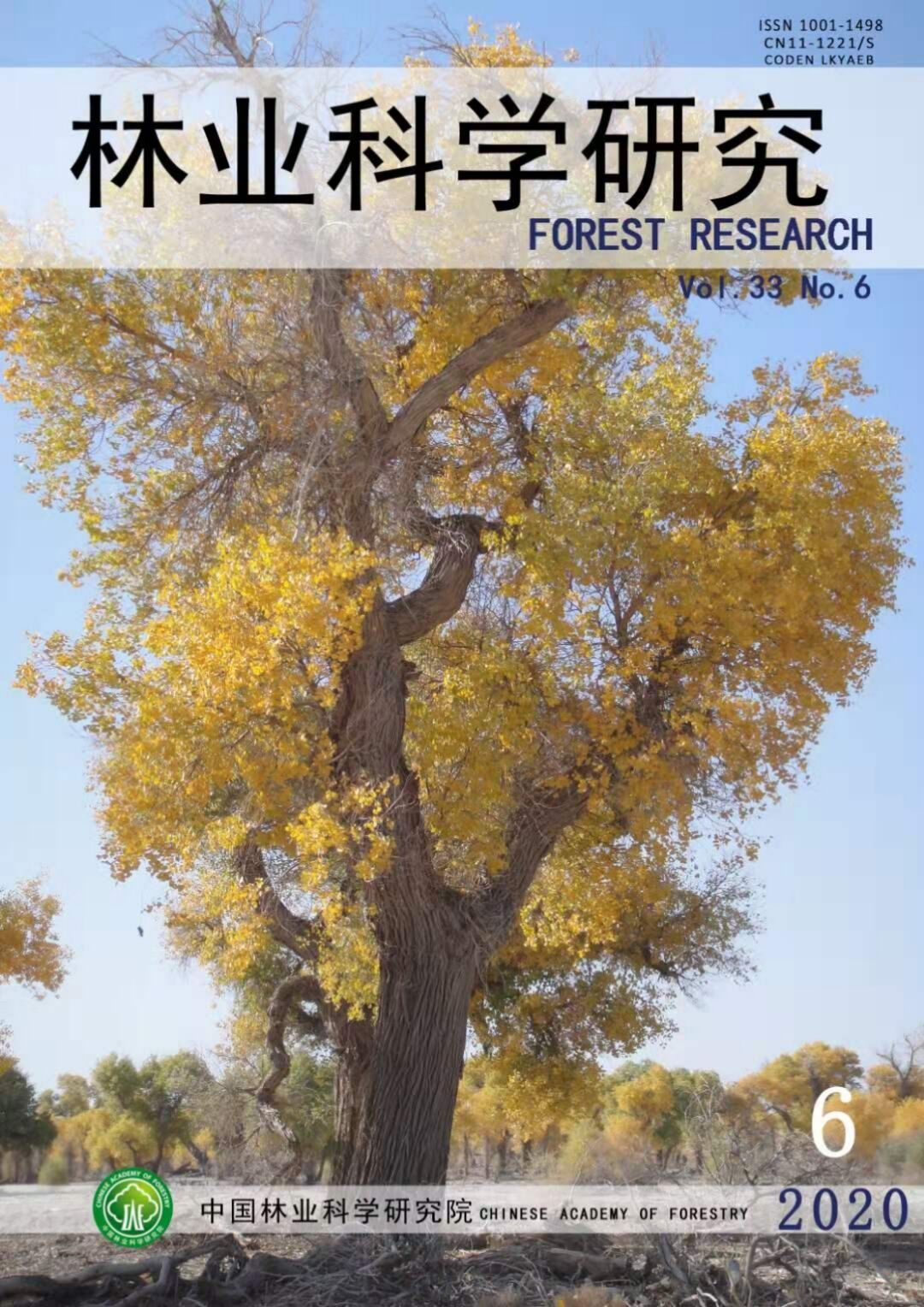


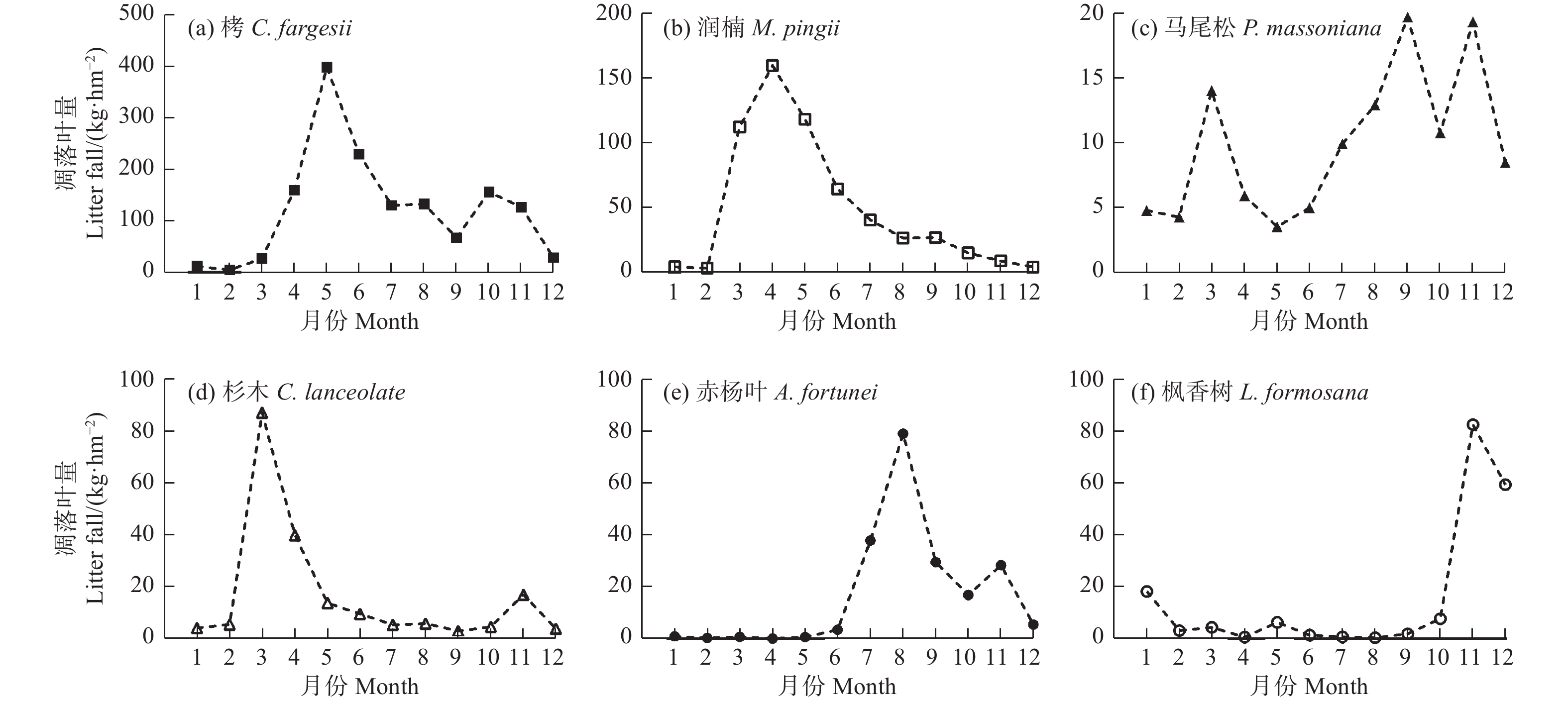

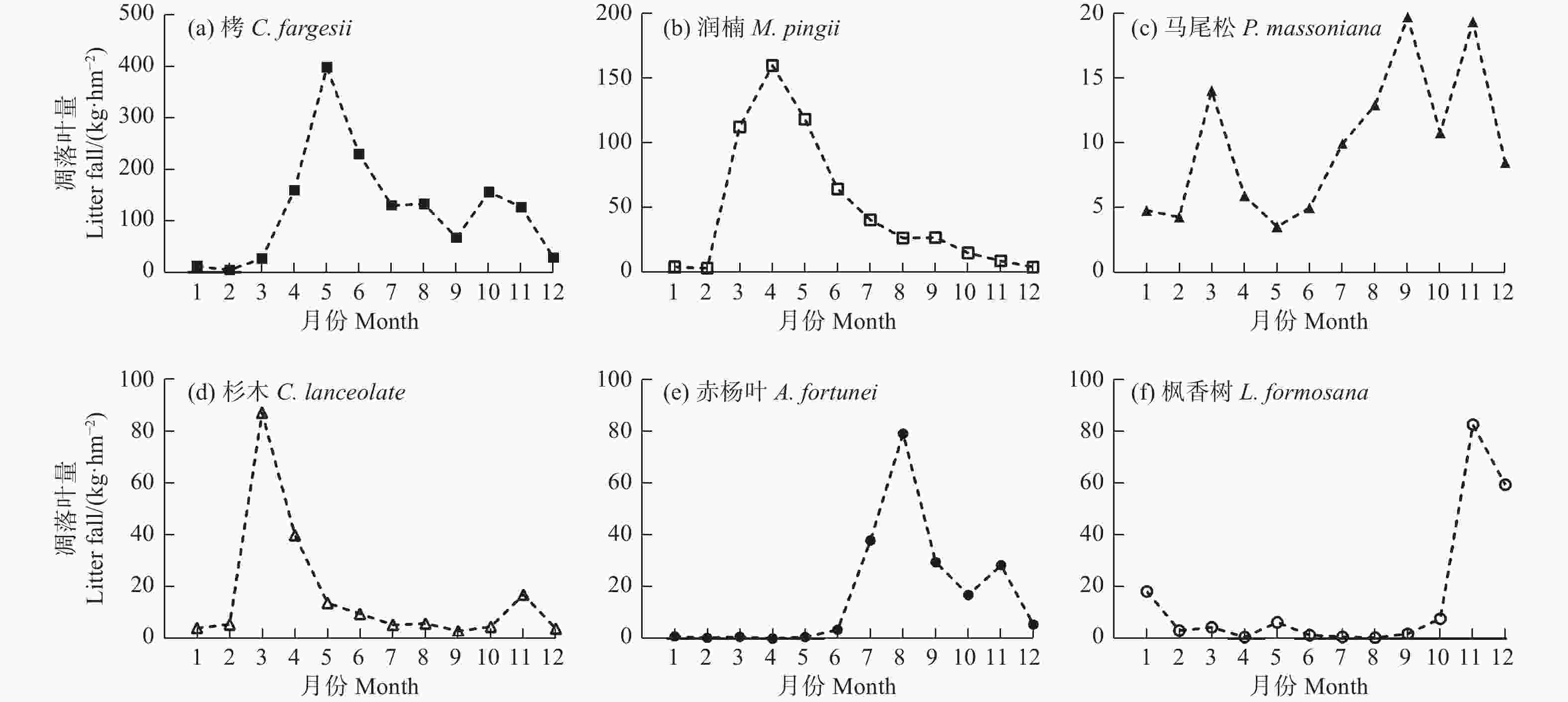
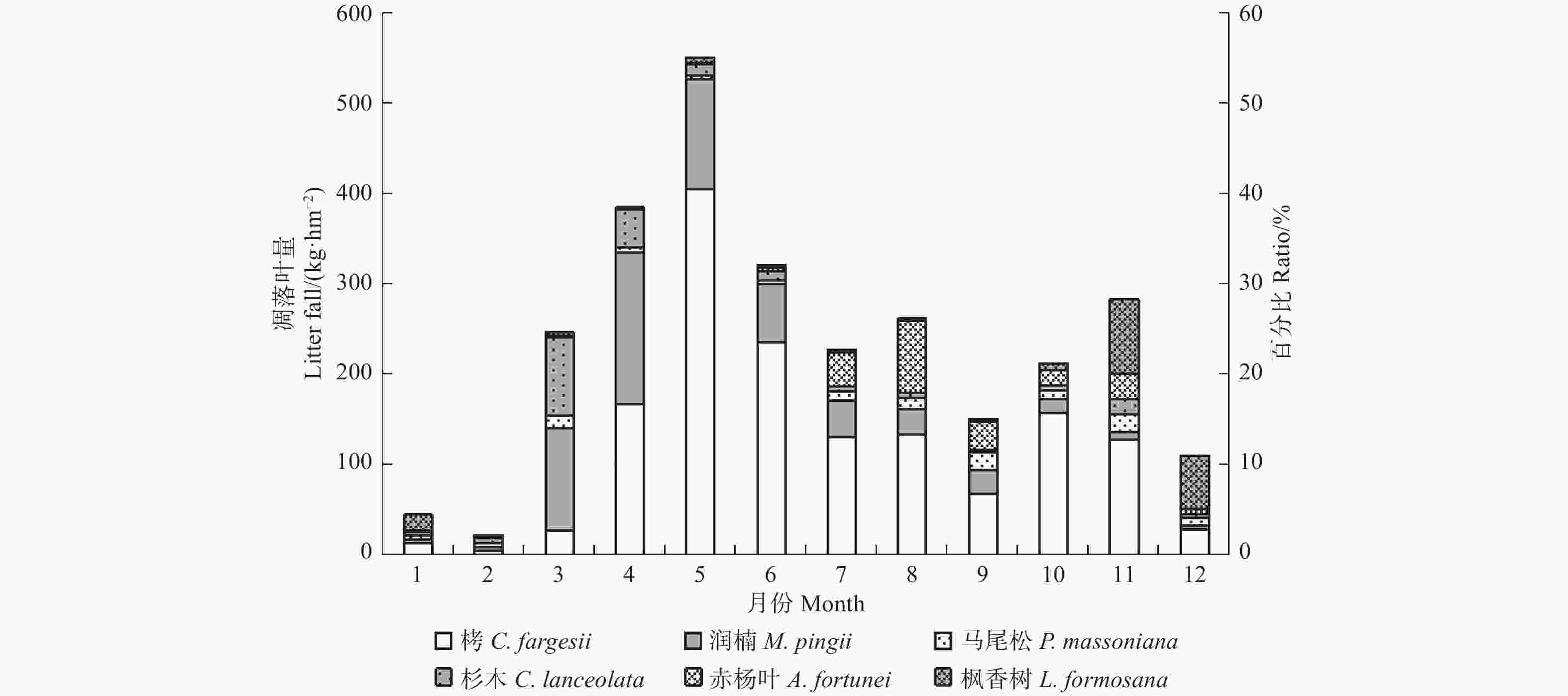
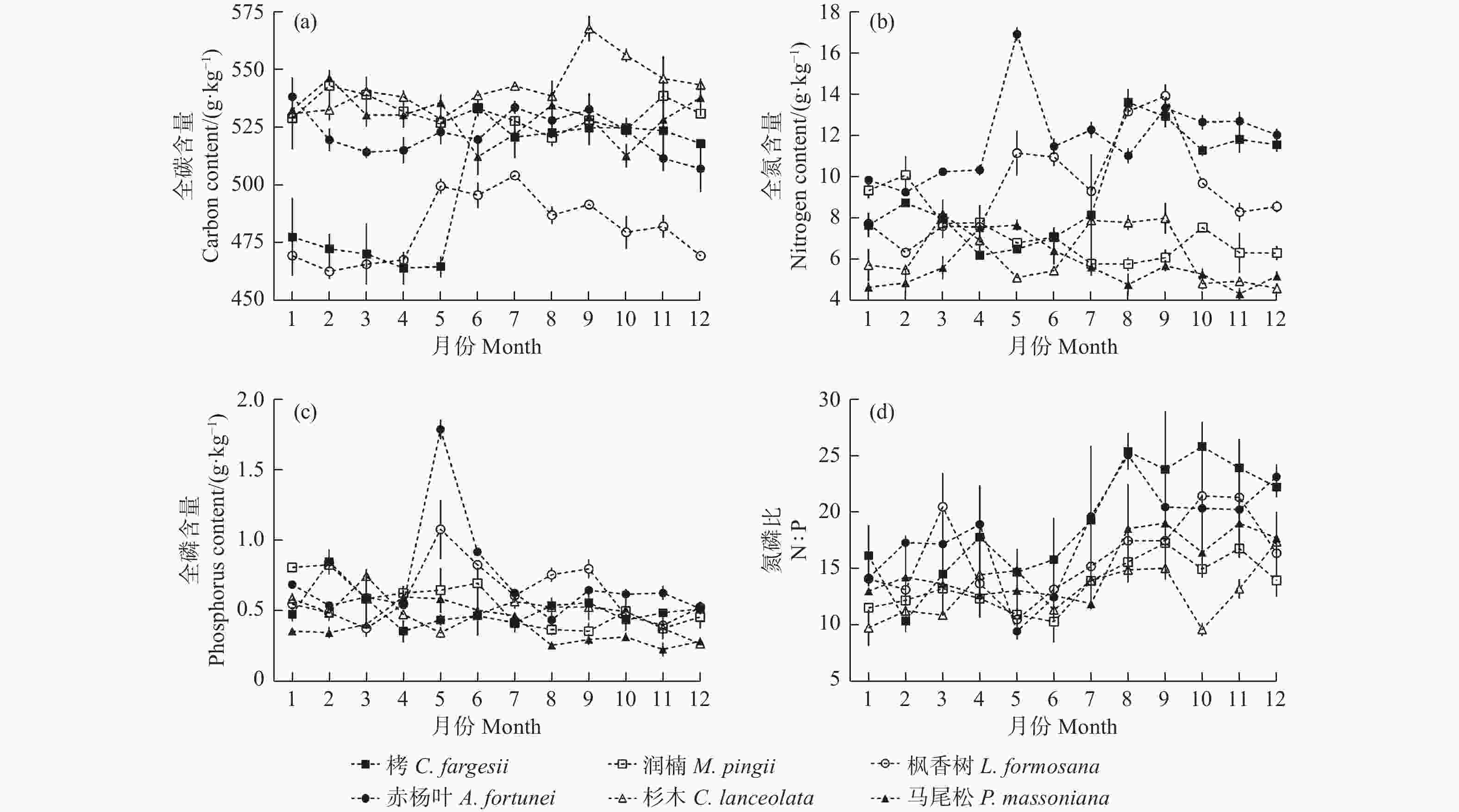
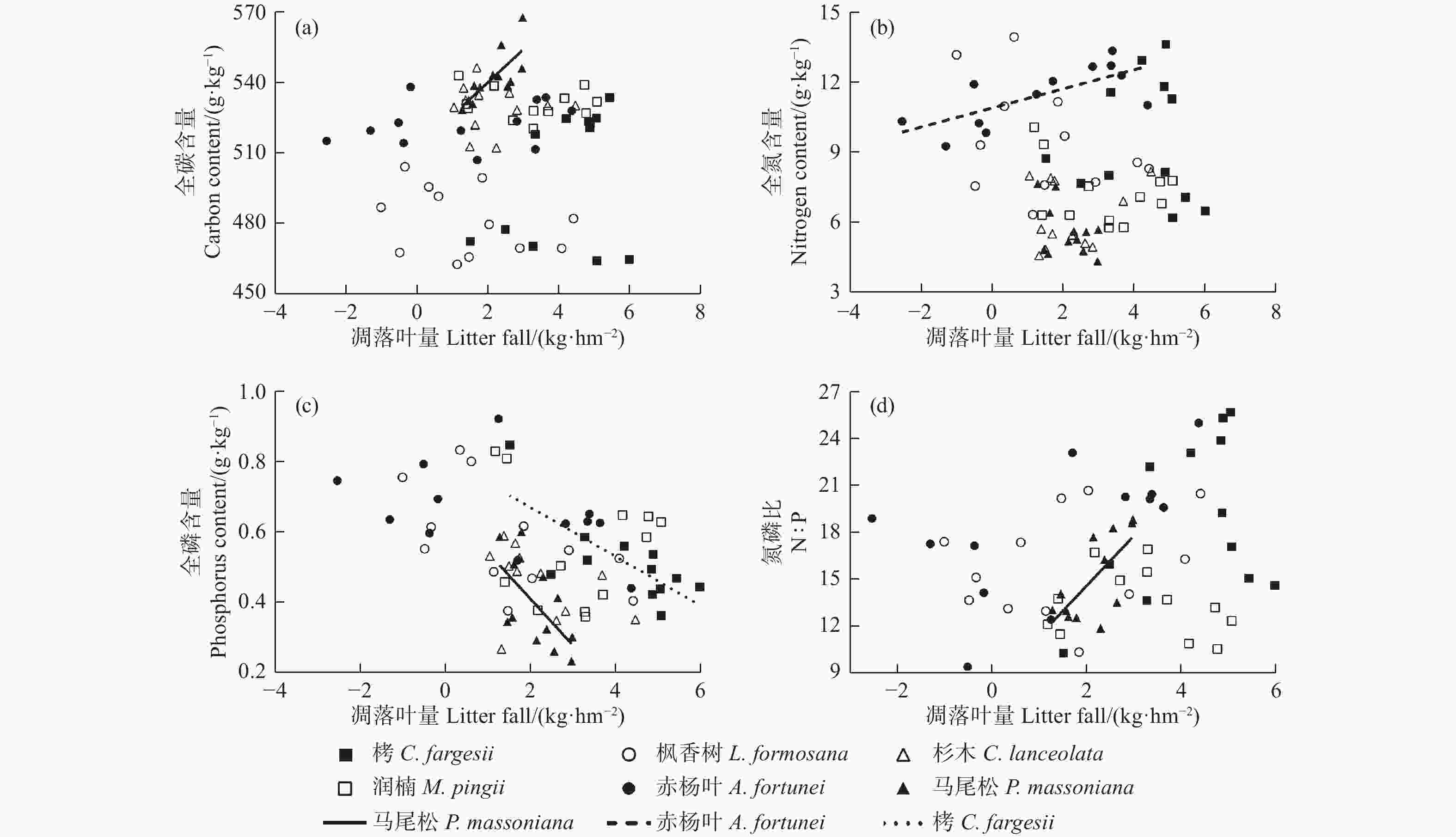
 DownLoad:
DownLoad:
